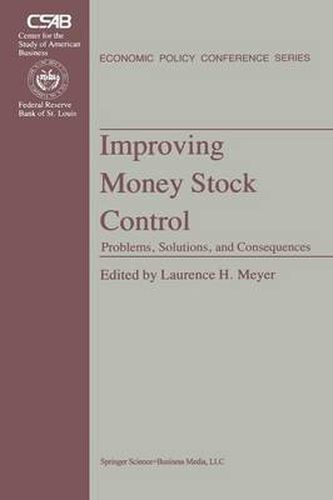Readings Newsletter
Become a Readings Member to make your shopping experience even easier.
Sign in or sign up for free!
You’re not far away from qualifying for FREE standard shipping within Australia
You’ve qualified for FREE standard shipping within Australia
The cart is loading…






This title is printed to order. This book may have been self-published. If so, we cannot guarantee the quality of the content. In the main most books will have gone through the editing process however some may not. We therefore suggest that you be aware of this before ordering this book. If in doubt check either the author or publisher’s details as we are unable to accept any returns unless they are faulty. Please contact us if you have any questions.
On October 30-31,1981, the Center for the Study of American Business and the Federal Reserve Bank of St. Louis cosponsored their sixth annual conference, Improving Money Stock Control: Problems, Solutions, and Consequences. This book contains the papers and comments delivered at that conference. The Federal Reserve System has moved, over the last decade, toward setting policy in terms of explicit and publicly announced monetary aggre gate targets - specifically, growth ranges for alternative measures of the money supply. This conference, as the title suggests, was wide ranging in its discussions of monetary control. But rather than dealing with the merits of monetary aggregate targeting, its focus was instead on solving the problems associated with, and evaluating the consequences of, im proved monetary control. The initial paper outlines the current operating procedures followed by the Federal Reserve and suggests reforms to improve monetary control. The following three discussion papers in Part I critically examine the Fed’s operating procedures. The two papers in Part II discuss the experi ence of other countries with monetary aggregate targeting - the United Kingdom and Switzerland, respectively - and Part III examines the con sequences of improved monetary control.
$9.00 standard shipping within Australia
FREE standard shipping within Australia for orders over $100.00
Express & International shipping calculated at checkout
This title is printed to order. This book may have been self-published. If so, we cannot guarantee the quality of the content. In the main most books will have gone through the editing process however some may not. We therefore suggest that you be aware of this before ordering this book. If in doubt check either the author or publisher’s details as we are unable to accept any returns unless they are faulty. Please contact us if you have any questions.
On October 30-31,1981, the Center for the Study of American Business and the Federal Reserve Bank of St. Louis cosponsored their sixth annual conference, Improving Money Stock Control: Problems, Solutions, and Consequences. This book contains the papers and comments delivered at that conference. The Federal Reserve System has moved, over the last decade, toward setting policy in terms of explicit and publicly announced monetary aggre gate targets - specifically, growth ranges for alternative measures of the money supply. This conference, as the title suggests, was wide ranging in its discussions of monetary control. But rather than dealing with the merits of monetary aggregate targeting, its focus was instead on solving the problems associated with, and evaluating the consequences of, im proved monetary control. The initial paper outlines the current operating procedures followed by the Federal Reserve and suggests reforms to improve monetary control. The following three discussion papers in Part I critically examine the Fed’s operating procedures. The two papers in Part II discuss the experi ence of other countries with monetary aggregate targeting - the United Kingdom and Switzerland, respectively - and Part III examines the con sequences of improved monetary control.